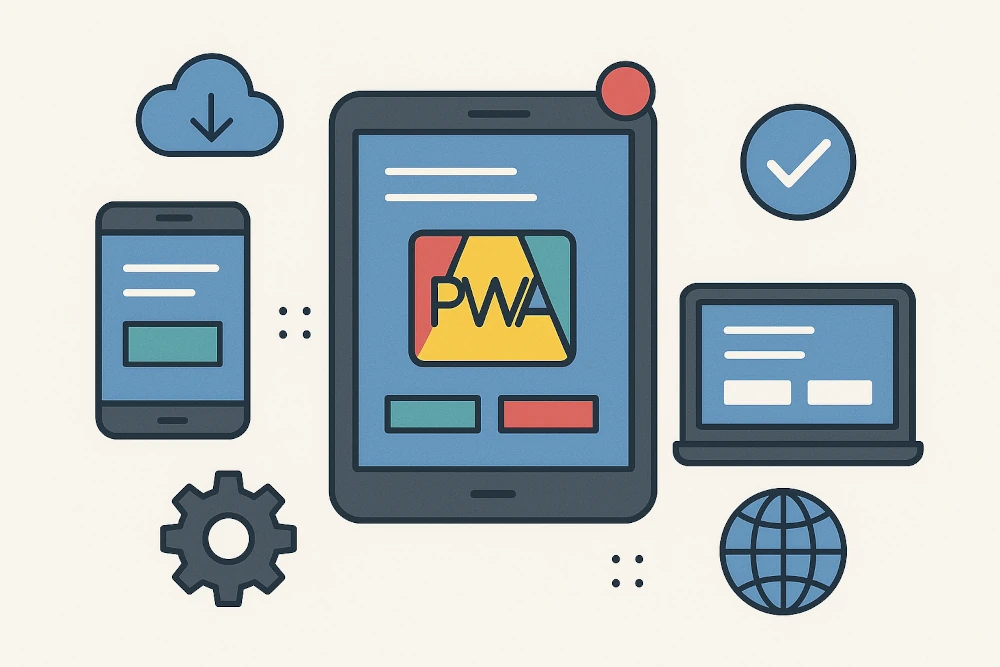Coined in 2015 by designer Frances Berriman and Google Chrome engineer Alex Russell, progressive cool web apps are cool web applications that load like regular web pages or websites but have the speed and agility to operate like an app. PWAs can offer UX such as working offline, push notifications, and device pwa hardware access traditionally available only to native applications.
Though our gizmos are stuffed with native apps that need to be made for the ordering-in-when-you’re-out generation (Just Eat, Foursquare, GrubHub, etc.) there’s always that access and network snafu.
That’s where PWA’s come in; they are hosted on the user’s servers and can be updated without any need of issuing new notifications to an app store. These web apps have all the native-like capabilities such as offline working, background refresh, quick loading, push notifications, and installability.

PWA Characteristics
- Progressive ― Regardless of browser choice, they should work for every user because they’re built with progressive enhancement as a core tenet
- Responsive ― Fit any form or factor: desktop, mobile and tablet
- Connectivity― Able to work offline, or on low-quality networks
- App-like ― Walk, swim and quack like the proverbial duck. Feature the native app-style interactions and navigations
- Fresh― Always up-to-date
- Safe ― Prevent snooping and ensure data integrity
- Discoverable ― Allow search engines to find them
- Re-engageable ― Make re-engagement easy through features like push notifications
- Installable ― Allow users to “keep” apps they find most useful on their home screen without the need of an app store
- Linkable ― Easily shared via an URL and do not require complex installation
According to statista.com, the number of mobile phones in use will hit 4.68 billion in 2019, which are already rich pickings for the business world and a no-brainer reason why they should embrace PWA technology.
Why should businesses get on the PWA train?
The native app market is declining
According to recode.net the App Store boom (circa 2008) may be over. It cited the latest research from Nomura, which relies on data from app tracker SensorTower, that the top 15 app publishers in USA saw downloads drop an average of 20 percent between May 2015 and May 2016. Notable exceptions were Uber and Snapchat (for this film everything generation). Outside the U.S., the top 15 apps grew by three percent.
PWA brands are blowing up
We’ve just mentioned travel ― with ride-sharing usage going through the roof ― as one sector that is benefitting from these new applications. For the on-the-go-traveller frustrated with spotty service, PWAs that are lightning fast with all sorts of timely push notifications for bonus points and travel updates can be a game changer.
But there are also significant gains being made in food and beverage, retail, and entertainment. Yes, we’ll all take a Frappuccino caramel to go. Starbucks made a sweet move when it rebuilt its native app as a PWA (even working in their payment and ordering methods), as mobile orders soared and UX greatly improved. The company saw a 65 percent increase in their rewards membership sign-ups via the web, with the Progressive Web Apps (PWA) allowing non-members to access the order feature without signing in.
Meanwhile, in retail could PWA’s be the shining White Knight to save the High Street? The new Debenhams site is one of the first PWAs in the country. Tapping Google-backed technology and delivered by Mobify and SapientRazorfish, the retailer boasts that it has more than doubled the speed of its previous site. Speaking after the site went live last October, Debenhams’ senior digital product manager, Jim Hingston, crowed: “There has been double-digit growth in our conversion so far. The speed is by far the most noticeable improvement; we’ve seen customers are able to complete some journeys over three times faster.”
In terms of entertainment let’s channel surf over to our aggressively capitalistic cousins across the Pond. Right now every American college sports fanatic is skiving off work, while glued to Progressive Web Apps (PWAs) like WatchESPN’s coverage of the NCAA “March Madness” Division I basketball championship. It’s a 68-team tournament hoops fest, that according to Kantar Media, a subsidiary of advertising giant WPP, trousered $1.285 billion in ad revenue in 2018. Formerly ESPN Networks, WatchESPN is an Internet television website and mobile application operated by ESPN Inc., a joint venture between the Walt Disney Company (which operates the network, through its 80 percent controlling interest) and Hearst Communications (which owns the remaining 20 percent). It provides nearly a dozen simulcasts that allow you to see every leg-breaking crossover, fade-away jumper and monster dunk in real time. Back in Blighty, Sky Sports and BT Sports have pioneered the superfast PWAs that deliver rolling footie coverage from any and every corner of the world through the likes of Sky Sports Mobile TV, Sky Go, BT Sport and BT TV.
Appy Days Ahead
In today’s Uber-connected world we can and – in the case of the millennial generation – do live our lives through web technology.
From taking Ubers for ridiculously small trips (they’ve replaced walking it seems), fashions sites for that head-to-toe “fierce” wardrobe and why cue up at the box office when you can order up your tickets to check out the latest Marvel blockbuster.
It’s all about instant gratification, and now there’s a new, cool web development kid in town by the name of progressive web applications (PWAs), which keeps the IT crowd buzzing 24/7 in work, rest or play.
In conclusion, therefore, it is clear that PWAs are indeed changing the game in our ever-changing, global existence. We demand things quicker, smarter with super reliability and this new world of web apps are well-positioned to deliver on all fronts.


